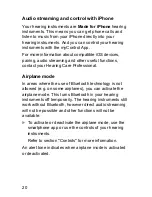
5
Your hearing instruments
This user guide describes optional features that
your hearing instruments may or may not have.
Ask your Hearing Care Professional to indicate the
features that are valid for your hearing instruments.
Instrument type
Your hearing instruments are BTE (Behind-The-Ear)
models. A tube delivers the sound from the hearing
instrument into the ear. The instruments are not intended
for children under the age of 3 years or persons with a
developmental age of under 3 years.
The wireless functionality enables advanced audiological
features and synchronization between your two hearing
instruments.
Your hearing instruments feature Bluetooth
®
low energy
*
technology allowing for easy and seamless audio
streaming and data exchange with your iPhone
**
.
*
The Bluetooth word mark and logos are owned by the Bluetooth SIG, Inc., and any
use of such marks by the legal manufacturer of this product is under licenses. Other
trademarks and trade names are those of their respective owners.
**
iPhone is a trademark of Apple Inc., registered in the U.S. and other countries.






































